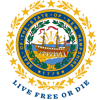Healthcare System Relief Fund
Information on COVID-19 Emergency Healthcare System Relief Fund Allocations
The Governor has authorized the allocation and expenditure of a total of $100 million in emergency funding from the CARES Act Coronavirus Relief Fund (“flex funds”) to support Healthcare providers with COVID-19 related expenses and lost revenues from March 1, 2020, to December 30, 2020. Of the $100 million in allocated funds, $87 million is dedicated for programs for Healthcare Providers and $30 million is dedicated for programs for Long Term Care Providers.
Healthcare Provider Relief Program
Governor Chris Sununu has authorized the allocation of $87 million in CARES Act Coronavirus Relief Fund (“flex funds”) to support all New Hampshire Healthcare Providers, other than Long Term Care providers, with COVID-19 related expenses and lost revenues from March 1, 2020, to December 30, 2020.
For any questions, the Department of Health and Human Services (DHHS) can be reached via email at
healthcarerelieffund@dhhs.nh.gov.
Healthcare Provider Relief Program Agreement
Initial Round Awards for Healthcare Providers
- COVID-19 Emergency Healthcare System Relief Fund Allocations as of June 11, 2020
- COVID-19 Emergency Healthcare System Relief Fund Allocations as of May 18, 2020
- COVID-19 Emergency Healthcare System Relief Fund Allocations as of May 5, 2020
- COVID-19 Emergency Healthcare System Relief Fund Allocations as of April 17, 2020
Second Round Awards for Healthcare Providers
Awards made under the second award round of the Healthcare System Relief Fund - Healthcare Provider Relief Program were determined utilizing the following formula:
In this round, applicants were asked to provide, among other things, (1) the estimated losses for March, April and May of 2020, (2) estimated additional Covid-19 related expenses incurred to date, and (3) the amount of assistance the applicant estimated it would need for the next two months. The awards were based on 50% of the amount of aid requested for the next two months, as long as that number was not greater than the actual decreased revenue in March, April and May 2020 as compared to the same months in 2019, plus actual expenses related to COVID -19 (total allowable costs to date). If the requested aid amount was greater than total allowable costs to date, or no amount was requested, an award was still be made of 50% of the total allowable costs. For purposes of this alternate award calculation, if the revenue figures did not show a loss for the three month period reported, the award could still be made based only on 50% of actual COVID-19 expenses. If not all months were provided, only those provided for both 2019 and 2020 were used. Finally, some applicants described expenses but provided no numeric values. Those applicants were given an opportunity to provide just the actual expenses identified in the application for up to June 19 when the application closed.
Third Round Awards for Healthcare Providers
Awards made under the third award round of the Healthcare System Relief Fund - Healthcare Provider Relief Program were determined utilizing the following formula:
In this round, applicants were asked to provide, among other things: (1) their actual 2019 gross receipts; (2) their estimated 2020 gross receipts; (3) their unanticipated expenses incurred due to responding to COVID; and (4) previous awards of funds from the Healthcare Relief Fund and/or other COVID-related relief funds.
First, GOFERR determined each applicant’s gross allowable losses by finding the difference between the applicant’s estimated gross receipts in 2020 and actual gross receipts in 2019 and then adding to that number the applicant’s actual unanticipated COVID-related expenses. GOFERR then subtracted the total amount of COVID-related relief funds already received from the applicant’s gross allowable losses to arrive at the applicant’s net allowable losses, if any.
Only those applicants with net allowable losses were eligible for an award. To ensure that each qualifying entity received funding, GOFERR made awards based on 15.81% of each applicant’s net allowable losses. GOFERR auditors performed pre-award reviews of the underlying documents in approximately 10% of the applications and adjusted claimed expenses to reflect only actual allowable expenses, if needed, for compliance. In the event that the application contained clerical errors that were identified through a review of the supporting documentation, awards were made based on the amount supported by the underlying documentation amount. All awards remain subject to audit.
Round 3 Awards for Healthcare Providers
Long Term Care Provider Program
Governor Chris Sununu has authorized the allocation of $30 million in CARES Act Coronavirus Relief Fund (“flex funds”) to support New Hampshire Long Term Care Provider, with COVID-19 related expenses and lost revenues from March 1, 2020, to December 30, 2020.
For any questions, the Department of Health and Human Services (DHHS) can be reached via email at:
LTCReliefFund@dhhs.nh.gov
Long Term Care Provider Program Agreement
First Round Awards for Long Term Care Providers
Awards made under the initial award round of the Healthcare System Relief Fund - Long Term Care Provider Program were determined utilizing the following formula:
In this round, applicants were asked to provide, among other things, (1) the estimated losses for March, April and May of 2020, (2) estimated additional Covid-19 related expenses incurred to date, and (3) the amount of assistance the applicant estimated it would need for the next two months. The awards were made based on 50% of the amount of aid requested for the next two months, as long as that number was not greater than the actual decreased revenue in March, April and May 2020, as compared to the same months in 2019, plus actual expenses related to COVID -19 (total allowable costs to date). If the requested aid amount was greater than total allowable costs to date, or if there was no amount requested, an award would still be made of 100% of the total allowable costs, unless review of the explanation showed that the expenses had already been reimbursed. For purposes of this alternate award calculation, if the revenue figures did not show a loss for the three month period reported, the award could still be made based only on actual unreimbursed COVID-19 expenses. For County facilities, as a government entity, the award could only be based on 100% of unreimbursed expenses. If not all months were provided, only those provided for both 2019 and 2020 were used. Finally, some applicants described expenses but provided no numeric values. Those applicants were given an opportunity to provide just the actual expenses identified in the application for up to June 19 when the application closed.
Second Round Awards for Long Term Care Providers
In this round, applicants were asked to provide, among other things: (1) their actual 2019 gross receipts; (2) their estimated 2020 gross receipts; (3) their unanticipated expenses incurred due to responding to COVID; and (4) previous awards of funds from the Healthcare Relief Fund and/or other COVID relief funds.
First, GOFERR determined each applicant’s gross allowable losses by finding the difference between the applicant’s estimated gross receipts in 2020 and actual gross receipts in 2019 and then adding to that number the applicant’s actual unanticipated COVID-related expenses. GOFERR then subtracted the total amount of COVID-related relief funds already received from the applicant’s gross allowable losses to arrive at the applicant’s net allowable losses, if any.
If the above-referenced calculation did not result in a net allowable loss, GOFERR used a second, alternative calculation to determine net allowable loss. This alternative calculation consisted of assessing whether the applicant’s total actual unanticipated COVID-related expenses were greater than the total amount of COVID-related relief funds already received. If so, GOFERR deemed the difference between the actual unanticipated expenses and the prior relief funds to be the applicant’s net allowable loss. Only those with net allowable losses were eligible for an award. To ensure that each qualifying entity received funding, GOFERR made awards based on 51.91% of each applicant’s net allowable losses. GOFERR performed a pre-award review of the underlying documents in approximately 50% of the applications and adjusted claimed expenses to reflect only actual allowable expenses, if needed, for compliance. All awards remain subject to audit.
For County facilities, as a government entity, the award could only be based on actual unreimbursed expenses. Accordingly, County facilities were awarded 51.91% of the total of actual unanticipated COVID related expenses minus the total amount of COVID-related relief funds already received.





